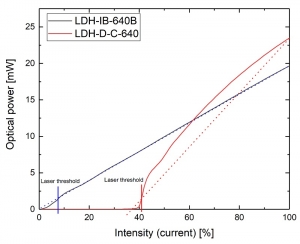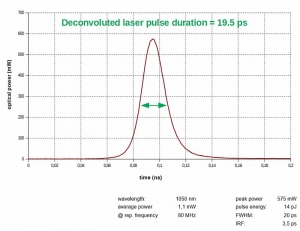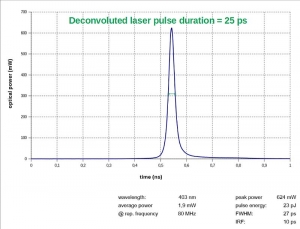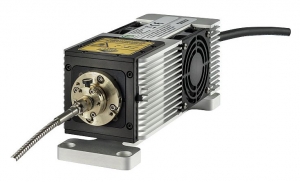Picosecond Pulsed Sources
LDH-I Series
Smart Laser Diode Heads for Taiko PDL M1
- Wavelengths between 375 nm and 1550 nm
- Pulse widths as short as 20 ps (FWHM)
- Repetition rate from single shot to 100 MHz
- Adjustable (average) power up to 200 mW
- Pulsed, bursts, and CW operation
- Power calibrated, operating hours counter, TE cooled
- Collimated beam, optional fiber coupling
- Dual calibration: max power and linear mode
- High power multimode diodes in Vis and NIR
 LDH-I Series features a large range of smart laser heads compatible with the Taiko PDL M1 driver. Laser heads from this series provide wavelengths in the spectral range from 375 to 1550 nm and include power calibrations. When coupled with a Taiko PDL M1, their optical output power can be controlled in both pulsed and continuous modes. Additionally, a wavelength calibration is available in CW mode. Each laser head is identified by the Taiko PDL M1 driver and includes not only linearized calibration data but also an operating hours counter.
LDH-I Series features a large range of smart laser heads compatible with the Taiko PDL M1 driver. Laser heads from this series provide wavelengths in the spectral range from 375 to 1550 nm and include power calibrations. When coupled with a Taiko PDL M1, their optical output power can be controlled in both pulsed and continuous modes. Additionally, a wavelength calibration is available in CW mode. Each laser head is identified by the Taiko PDL M1 driver and includes not only linearized calibration data but also an operating hours counter.
Pulse widths down to 20 ps
 All laser heads emit picosecond pulses with a full width at half maximum (FWHM) typically around 90 ps or below. For some laser heads even pulse widths down to 20 ps are possible. The pulse width itself cannot be controlled directly, but does depend on the selected power level of the diode. At maximum intensity, the pulse width can broaden.
All laser heads emit picosecond pulses with a full width at half maximum (FWHM) typically around 90 ps or below. For some laser heads even pulse widths down to 20 ps are possible. The pulse width itself cannot be controlled directly, but does depend on the selected power level of the diode. At maximum intensity, the pulse width can broaden.
Adjustable and calibrated average power
 The laser heads are calibrated for two distinct modes: the classic linear mode the new max. power mode.
The laser heads are calibrated for two distinct modes: the classic linear mode the new max. power mode.
In linear mode, both pulse energy and pulse shape are guaranteed to remain constant over the entire range of repetition rates for a given intensity setting. This ensures a very stable instrument response function (IRF) for, e.g., lifetime measurements and offers perfect linearity of average power for every repetition rate. As a consequence, doubling the repetition rate therefore effectively doubles the average output power.
The max. power mode allows reaching the highest pulse energy at each repetition rate. The exact amount of extra power that can be achieved depends both on the connected laser head as well as on the repetition rate at which it is operated.
In either mode the pulse energy increases linearly with the intensity setting (in %).
The levels of average optical output power are measured and saved in the internal memory of the laser head as mW / W calibration data for all repetition rates between 1 MHz and 100 MHz typically. The average power in CW mode is calibrated as well.
Three lasing regimes of the laser diode, which depend on the intensity setting, are identified and plotted: spontaneous emission (below laser threshold), short pulse (lower intensity setting), broaden pulse (higher intensity setting). The currently set regime is recognized and shown on the local display of the Taiko PDL M1 with an intuitive color code on the intensity scale.
The achievable pulse energies range from several tens of pico joule to up to 2 nanojoules , which corresponds to maximum average output powers of up to 150 mW milliwatts at high repetition rate.
Repetition rates up to 100 MHz
All laser heads are designed to work at repetition rates from single shot up to values in the MHz range. The maximum repetition rate depends on each single diode and is typically 100 MHz. For some laser heads a maximum repetition rate of e.g., 60 MHz is recommended in order to ensure a constant pulse energy at all repetition rate.
Pulsed, bursts and CW operation
All laser heads of the LDH-I Series can be operated in pulsed, burst, and CW mode. While the pulsed mode corresponds to a constant repetition rate commonly used for time-resolved measurement, the burst mode enables generation of flexible bursts of pulses (with selectable amount of pulses and burst period) which is useful for measuring long lifetime decays, laser ranging applications and specific seeding tasks. The CW mode enables a much higher average laser power.
Hot plug capable
As an additional feature, laser heads of the LDH-I Series are capable of hot plugging. This means that swapping laser heads to change wavelength no longer requires to turn off the driver.
Fiber coupling
The laser heads of the LDH-I Series can be optionally coupled into a variety of optical fibers (multi-mode, single mode, or polarization maintaining single mode) via different connector types. We recommend FC/APC connectors for most applications, since they prevent back reflections that can interfere with laser stability. For details see our solutions for fiber coupling.
General specifications
| Beam parameters1 | |
|---|---|
| Optics focus length | f' = 4.5 mm (Typ. for most LDH-IB) f' = 9.0 mm (Typ. for LDH-IB-xxx-T) |
| Numerical aperture | 0.55 |
| Typical divergence (with optics) | Theta parallel 0.11 mrad Theta perpendicular 0.32 mrad |
| Beam shape | Elliptical shape, typ. dimensions 1.5 × 3.5 mm |
| Polarization | typ. linear, perpendicular to the longer axis of the elliptical beam2 |
| Polarization Extinction Ratio (PER) | typ. > 1:10 (> 10 dB) |
| Side mode suppression ratio (SMSR) | typ. < 0.01 |
| Cooling | |
| Peltier cooling stability | better than 1 K for ambient temperature between 15°C and 30°C |
| Dimensions | |
| Cylinder | 76 × 175 mm (diameter × length) |
| Cylinder with fiber coupling | 76 × 207 mm (diameter × length) |
| Cuboid | 175 × 77 × 83.7 mm (lenght × width × height) |
| Cuboid with fiber coupling | 207 × 77 × 83.7 mm (length × width × height) |
| Spectral width3 | |
| Wavelengths < 900 nm | approx. 2 to 8 nm |
| Wavelengths > 900 nm | approx. 10 to 20 nm |
| CW operation | < 1 nm |
| Power stability | |
| 12 hours, Delta T (ambient) < 3 K | 1 % RMS, 3 % peak to peak |
1the values of beam parameter are typical values. Some fluctuation may occur. In particular the beam divergence can be larger for multimode diode laser diode head (LDH-IB-XXX-M).
2 a few exceptions may occur
3 narrow bandwidth on request
All Information given here is reliable to our best knowledge. However, no responsibility is assumed for possible inaccuracies or omissions. Specifications and external appearances are subject to change without notice.
The following tables list the pulse parameters and power values of the available wavelengths of the LDH-I Series (available between 375 and 1550 nm). The two power adjustment levels specified here refer to the same laser head. These levels can be adjusted using the corresponding driver Taiko PDL M1. The 'Low' adjustment is the best choice for shortest pulses and is usually reached close to the lasing threshold. The 'High' adjustment is used to achieve highest pulse power and corresponds to the maximum intensity setting of the driver. These laser heads have a spectral width of a few nm. Special selected laser heads with narrow spectral bandwidth can also be provided.
The table below is updated on a regular basis based on data of recently manufactured laser heads. Other specifications such as shorter pulse widths, higher powers, further wavelengths might be possible on request.
Please contact us for more information.
| Wavelength (± 10) [nm] |
Type (LDH-) |
Pulse1 (FWHM) [ps] |
Max. rep. rate [MHz] | High avg. power2 [mW] | Low avg. power3 [mW] | CW power [mW] |
| 375 | IB-375-P | < 40 | 70 | 3.0 | 1.0 | 10 |
| 375 | IB-375-B | < 70 | 80 | 7.0 | 1.5 | 20 |
| 375 | IB-375-M-P | < 90 | 50 | 8.0 | 3.0 | 100 |
| 375 | IB-375-M | < 110 | 50 | 35.0 | - | 100 |
| 395 | IB-390-B | < 70 | 100 | 20.0 | 3.0 | 50 |
| 405 | IB-405-P | < 40 | 80 | 4.0 | 1.0 | 10 |
| 405 | IB-405-B | < 50 | 100 | 20.0 | 3.0 | 50 |
| 405 | IB-405-M-P | < 100 | 50 | 50.0 | 10.0 | 200 |
| 405 | IB-405-M | < 160 | 50 | 85.0 | - | 200 |
| 420 | IB-420-B | < 60 | 100 | 12.0 | 2.0 | 50 |
| 440 | IB-440-B | < 80 | 100 | 25.0 | 1.0 | 50 |
| 440 | IB-440-M-P | < 100 | 80 | 30.0 | 10.0 | 200 |
| 440 | IB-440-M | < 160 | 50 | 85.0 | - | 200 |
| 450 | IB-450-B | < 70 | 80 | 12.0 | 2.0 | 50 |
| 450 | IB-450-M-P | < 110 | 50 | 40.0 | 5.0 | 200 |
| 450 | IB-450-M | < 220 | 50 | 85.0 | - | 200 |
| 470 | IB-470-B | < 80 | 100 | 15.0 | 1.0 | 50 |
| 470 | IB-470-M-P | < 110 | 80 | 40.0 | 15.0 | 200 |
| 470 | IB-470-M | < 220 | 50 | 100.0 | - | 200 |
| 485 | IB-485-P4 | < 120 | 60 | 3.0 | 1.5 | 40 |
| 485 | IB-485-B4 | < 120 | 100 | 10.0 | 1.0 | 50 |
| 485 | IB-485-M-P | < 140 | 50 | 35.0 | 20.0 | 200 |
| 485 | IB-485-M | < 220 | 50 | 100.0 | - | 200 |
| 500 | IB-500-B | < 110 | 70 | 7.0 | 1.8 | 40 |
| 510 | IB-510-P4 | < 100 | 100 | 1.0 | 0.5 | 15 |
| 510 | IB-510-B4 | < 110 | 50 | 7.0 | 0.7 | 40 |
| 515 | IB-520-B4 | < 160 | 100 | 7.0 | 1.0 | 20 |
| 520 | IB-520-M-P | < 130 | 50 | 13.0 | 6.0 | 200 |
| 520 | IB-520-M | < 200 | 50 | 50.0 | - | 200 |
| 532 (± 3) | IB-530-T-P5 | < 80 | 100 | - | 0.5 | 20 |
| 532 (± 3) | IB-530-T-B5 | < 80 | 100 | 1.1 | - | 20 |
| 561 (± 3) | IB-560-T-P5 | < 80 | 100 | - | 0.5 | 20 |
| 561 (± 3) | IB-560-T-B5 | < 80 | 100 | 0.9 | - | 20 |
| 594 (± 3) | IB-595-T-P5 | < 100 | 100 | - | 0.2 | 5 |
| 594 (± 3) | IB-595-T-B5 | < 100 | 100 | 0.5 | - | 5 |
| 640 | IB-640-P | < 55 | 100 | 1.0 | 0.5 | 5 |
| 640 | IB-640-B | < 90 | 100 | 30.0 | 3.0 | 50 |
| 640 | IB-640-M-P | < 130 | 60 | 40.0 | 4.5 | 100 |
| 640 | IB-640-M | < 160 | 70 | 50.0 | - | 100 |
| 655 | IB-650-P | < 60 | 100 | 1.0 | 0.5 | 5 |
| 655 | IB-650-B | < 70 | 100 | 10.0 | 2.5 | 10 |
| 660 | IB-660-B | < 100 | 100 | 20.0 | 3.0 | 50 |
| 670 | IB-670-P | < 50 | 100 | 2.5 | 1.0 | 5 |
| 670 | IB-670-B | < 70 | 100 | 7.0 | 0.8 | 10 |
| 685 | IB-690-B | < 80 | 100 | 10.0 | 1.0 | 20 |
| 705 | IB-705-B | < 70 | 100 | 20.0 | 3.0 | 25 |
| 730 | IB-730-B | < 80 | 100 | 20.0 | 3.0 | 20 |
| 760 | IB-760-B | < 110 | 100 | 9.0 | 2.0 | 20 |
| 780 | IB-780-B | < 70 | 100 | 30.0 | 1.0 | 40 |
| 780 | IB-780-M-P | < 150 | 100 | 40.0 | 12.0 | 100 |
| 780 | IB-780-M | < 220 | 80 | 110.0 | - | 100 |
| 805 | IB-810-B | < 110 | 80 | 10.0 | 1.5 | 50 |
| 805 | IB-810-M-P | < 70 | 100 | 50.0 | 5.0 | 200 |
| 805 | IB-810-M | < 160 | 80 | 110.0 | - | 200 |
| 830 | IB-830-B | < 70 | 100 | 10.0 | 0.3 | 20 |
| 830 | IB-830-M-P | < 90 | 100 | 50.0 | 12.0 | 200 |
| 830 | IB-830-M | < 160 | 80 | 110.0 | - | 200 |
| 840 | IB-840-B | < 70 | 100 | 15.0 | 0.8 | 20 |
| 850 | IB-850-B | < 90 | 80 | 10.0 | 3.0 | 50 |
| 905 | IB-905-B | < 100 | 100 | 8.0 | 2.0 | 50 |
| 910 | IB-910-M-P | < 100 | 80 | 20.0 | 10.0 | 200 |
| 910 | IB-910-M | < 180 | 80 | 150.0 | - | 200 |
| 940 | IB-940-B | < 90 | 100 | 6.0 | 2.0 | 50 |
| 975 | IB-980-B | < 100 | 100 | 7.0 | 1.8 | 50 |
| 980 | IB-980-M-P | < 90 | 100 | 35.0 | 4.0 | 200 |
| 980 | IB-980-M | < 180 | 80 | 100.0 | - | 200 |
| 1062 (± 3) | IB-1060-B | < 130 | 100 | 10.0 | 1.2 | 40 |
| 1062 (± 20) | IB-1060-M-P | < 80 | 100 | 35.0 | 4.0 | 200 |
| 1062 (± 20) | IB-1060-M | < 250 | 80 | 100.0 | - | 200 |
| 1310 (± 20) | IB-1310-B | < 50 | 100 | 3.0 | 0.1 | 5 |
| 1550 (± 3) | IB-1550-B | < 40 | 100 | 3.0 | 0.1 | 10 |
1 Shortest pulse width at min intensity setting above laser threshold. Possible pulse broadening at high intensity settings
Pulses are deconvoluted with 30 ps detection IRF. Shorter pulse widths are available on demand.
2 Average optical power at optimal repetition rate and max intensity setting (in max power mode)
3 Average optical power at max repetition rate and min intensity setting above laser threshold (in linear and in max power mode).
4 Different coupling efficiency into optical fibers for pulsed and CW operation due to astigmatism and possible wavelength shift. The coupling is optimized for pulsed operation as standard.
5 Amplified laser heads are excluded from the 5-year limited warranty.
Naming scheme of the LDH-I Series laser heads
Description:
"I" = Taiko compatible, "intelligent"
"M" = Multimode diode, reduced coupling efficiency into single mode fibers, not suited for microscopy applications
"T" = Tapered amplified
"P" = Narrow pulse
"B" = High power
All measurements shown may be subject to a 10% callibration error.
Each laser head undergoes an extensive burn-in test to ensure long-term stability and is shipped with a comprehensive set of test data. This test data is kept in our database, which already holds records of more than 15 years.
All Information given here is reliable to our best knowledge. However, no responsibility is assumed for possible inaccuracies or omissions. Specifications and external appearances are subject to change without notice.
The smart picosecond pulsed diode lasers of the LDH-I Series can be used for various applications, where short pulses with high and variable repetition rates as well as stable pulse energies are important, such as:
- Time-Resolved Fluorescence
- Fluorescence Lifetime Imaging (FLIM)
- Phosphorescence Lifetime Imaging (PLIM)
- Fluorescence Correlation Spectroscopy (FCS)
- Fluorescence Lifetime Correlation Spectroscopy (FLCS)
- Foerster Resonance Energy Transfer (FRET)
- Stimulated Emission Depletion Microscopy (STED)
- Dual Focus Fluorescence Correlation Spectroscopy (2fFCS)
- Pulsed Interleaved Excitation (PIE)
- Fluorescence Anisotropy (Polarization)
- Singlet Oxygen
- Laser Cutting/Ablation
- Time-Resolved Photoluminescence (TRPL)
- TRPL Imaging
- Lanthanide Upconversion
- Laser Seeding
- LIDAR/Ranging/SLR
- Antibunching
- Diffuse Optical Tomography and Imaging
- Single Molecule Spectroscopy / Detection
- Single Photon Generation
- Time response characterization of opto-electronic devices
The following documents are available for download:
Latest 10 publications referencing Pulsed Diode Lasers (PDL Series, LDH-Series, LDH-FA Series)
The following list is an extract of 10 recent publications from our bibliography that either bear reference or are releated to this product in some way. Do you miss your publication? If yes, we will be happy to include it in our bibliography. Please send an e-mail to info@picoquant.com containing the appropriate citation. Thank you very much in advance for your kind co-operation.


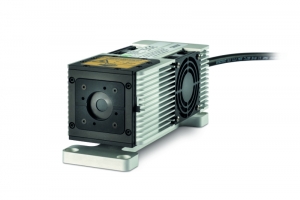
 Contact us
Contact us

